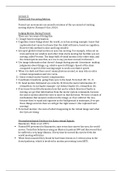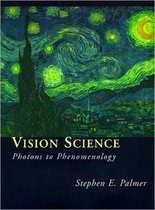Lecture 3:
Pursuit and Perceiving Motion:
Pursuit eye movements are smooth rotations of the eye aimed at tracking
moving objects (Furman & Gur, 2012).
Judging Motion During Pursuit:
There are two ways of doing this:
1) Image-based compensation:
Cognition: know things about the world, so in boy moving example- know that
cupboards don’t move but know that the child will move, based on cognition.
However this method is slow and long-winded.
Interpret global retinal motion as eyes/me moving. For example, when sat on
train and look out window and other train starts moving but feel like you are
moving, called Vection. The large bulk of visual motion is the other train, and
the visual system uses this, as a cue to say you have moved, but haven’t.
Use image information that doesn’t change during pursuit (invariants- making
judgments about things, e.g. relative speed of things). Speed of the chair
compared to speed of the moving target to work out relative speed.
When it is dark and there aren’t many photons around, so may rely on extra
retinal compensation and vice versa.
2) Extra-retinal (motor-based) compensation:
Coordinate transform- going from eyes to the head. Perceived (H)= R + E.
H= head motion. Estimated eye velocity (E) from the motor information. R=
retinal flow. So in Charlie example- eye follow Charlie (E), retinal flow (R).
If we know from ER information how fast and in which direction Charlie is
moving, we get that information from the motor system commands, because
the motor system asked the eyes to move in that direction. We have a bunch of
mechanisms that measure motion in the image, so if we subtract the two,
because they're equal and opposite as the background is stationary, if we get
these things accurate then we will get the right answer (the cupboard isn’t
moving).
Perceived motion= the sum of what’s happening in the retinal image and what
the eyes are doing.
Neurophysiological Evidence for Extra-retinal Signals:
Haarmeier, Thier et al (1997):
Patient RW presented to Haarmeier, says every time moves his eyes, the world
moves. Tested his behaviour using an illusion in patient RW and discovered that
he suffered a very large illusion. (Every time he moved his eyes he feels the
world moving with him).
When brain scanned they found he had brain lesions in 3 critical areas in the
dorsal pathway, which is involved in motion processing (area MST).





